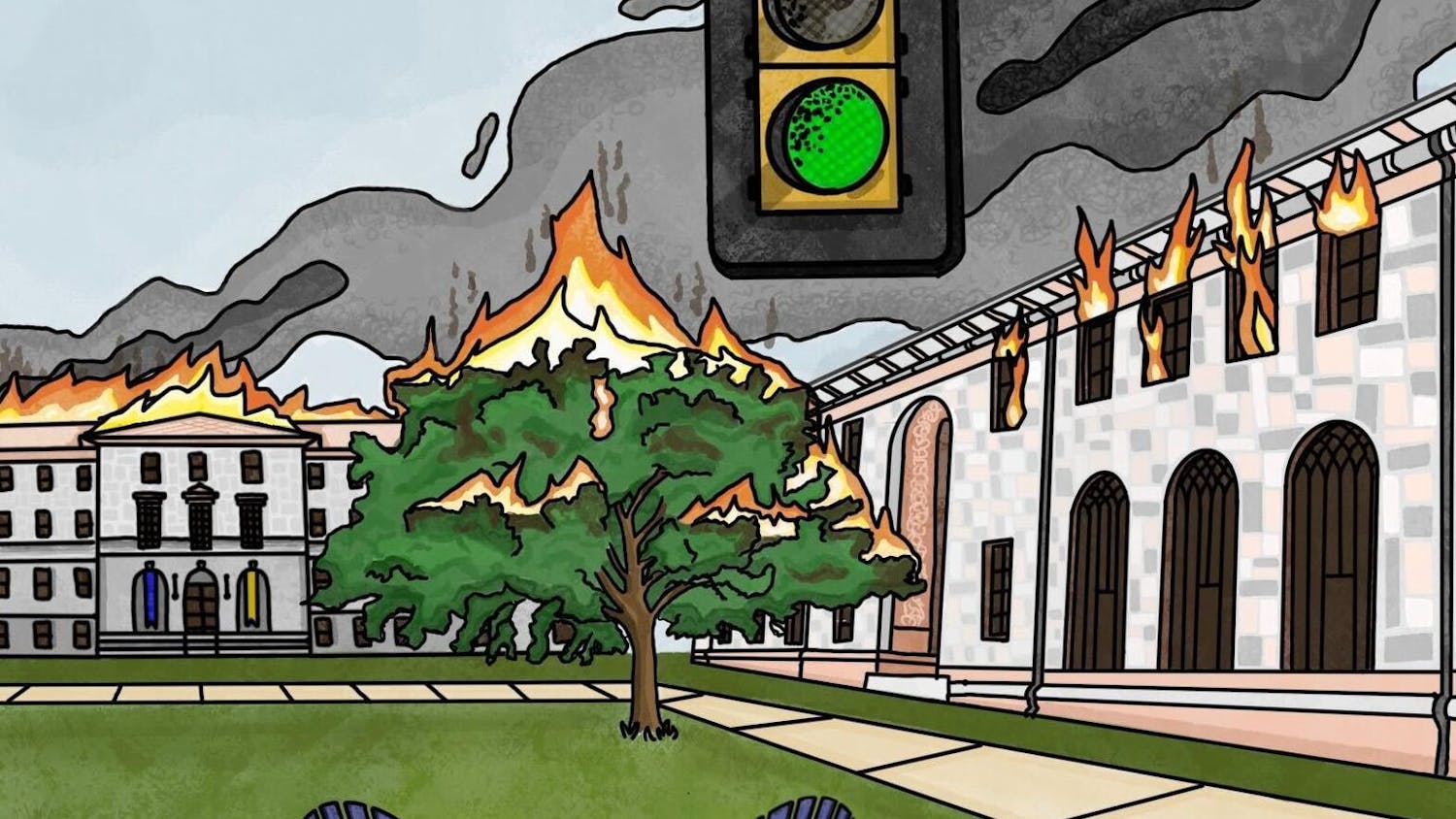
The theater is boisterous, full of moviegoers simultaneously enraptured by the screen and dedicated to delivering their cynical personal commentary. Minutes earlier, young women arrived in droves to share popcorn and twizzlers, interlocking their fingers in solidarity as they waltzed down the aisles. Mere minutes into the film, the theater erupted with chuckles and comedic remarks — but this story is no laughing matter. It is fascinating, shocking and sickening. It is “Priscilla.”
Written and directed by Sofia Coppola, “Priscilla” premiered in theaters nationwide on Nov. 3. The movie follows the tumultuous romantic relationship between Priscilla Presley and Elvis Presley. Priscilla served as executive producer, both influencing and approving of this narrative.
At the onset of the film, the lovers meet in 1959 at one of Elvis’ house parties on a U.S. military base in Germany. Priscilla (Cailee Spaeny) is starstruck and immediately infatuated with the charismatic, handsome Elvis (Jacob Elordi). He inquires about her year in school to which Priscilla sheepishly replies — ninth. Elvis is 24 at the time. Spaeny effortlessly established Priscilla’s innocence by adopting her meek voice and embodying a self-conscious body language. With the audience’s knowledge of their soon-to-be relationship, the scene was hard to swallow.
After their initial meeting, the romance never stops. Although a brief hiatus occurs while Elvis serves in the army, Priscilla’s devotion toward the star never falters. The young girl moves to Graceland, Elvis’ home in Memphis, Tenn., at 17 to finish her schooling in his company.
The cinematography in “Priscilla” balances the genuine beauty of an all-encompassing love story with the uncomfortable and dark reality of the relationship. The scenes are shot in low light with shadows often half-concealing Elvis’ face and figure. Close-ups of Priscilla’s youthful face and soft makeup juxtapose the young girl with Elvis’ adult friends. The camera often lingers uncomfortably long, forcing the audience to reconcile the delicate nature of Priscilla with Elvis’ dominance. When Elvis gifts Priscilla a golden watch for Christmas, his giant hands envelop her dainty, doll-like wrist.
The strongest features of the film are the costume design and casting. The evolution of Priscilla’s wardrobe painfully reflects the loss of her innocence and personal agency. In the beginning of the relationship, Priscilla dresses her age, frequently wearing baby-pink billowy dresses, ballet flats and soft curls in her hair. Soon enough, Elvis exerts his influence over Priscilla’s style, having her dye her hair black, wear intense eyeliner and resign herself to vibrant blue fabrics. In a truly gut-wrenching scene, Elvis bluntly tells Priscilla what she needs to change about herself. Judging by the solemn silence following Elvis’ unapologetic control over Priscilla’s look, I noticed this scene quickly resonated with the predominantly female audience.
Elvis is grandiose, larger-than-life in his stardom and demeanor. Yet, the attention is not on the screaming fans or the flashing lights in “Priscilla.” Instead of following Elvis like a groupie at his heels, the movie stays with Priscilla, locked up in Graceland. The audience was isolated with her, hidden from the media and bored out of our minds. We were restless and restrained. The film is slow, soft and intimate — and Priscilla is the star.
Elordi is the perfect Elvis. His natural charisma and good looks that many young women have been delighted by since his performance on “Euphoria” (2019) enabled the audience to sympathize with Priscilla. Not only is he obnoxiously handsome, but he is also intimidating. How could she say no? How could her parents? Elordi is romantic, protective and, of course, literally Elvis. Spaeny captured this dilemma perfectly. She is young and naive and desperately wants his attention. Elvis takes advantage of her, and as a result, Priscilla completely loses agency over her life, body and mind.
The movie is uncomfortable at times, and rightfully so. It is a depiction of a wild romance, but it is also the depiction of predator and prey, of the too-familiar story of older men manipulating and abusing young women — a dynamic that pervades our present society.
In all transparency, I was one of the many women in the theater making sarcastic comments, laughing at Elvis’ behavior and pretending I would be smarter than Priscilla — that I would never endure this treatment. But I have, and so have the majority of women in that theater. We laughed not because it is funny, but because it is horrifying. To poke fun at Elvis, a superstar with a terrifying temper and a strange obsession with faux tigers, is easy. But to recognize the emotional trauma Priscilla underwent and how her situation reflects the many abuses women suffer in relationships daily is not. Coppola forces the audience to sit in silence with Priscilla, and as a result, sit with themselves.
“Priscilla” is not a love story. It is a raw depiction of the dangerous reality many young women face in romantic relationships. It is nauseating and scary but also beautiful and timeless. I urge everyone, especially women, to watch the film. It is pain under the veil of beauty. It hurts, but in the most wonderful way.
Catherine Goodman (26C) is the Managing Editor of Arts & Life and Editorial Board. She is a double major in English and Art History. She plans to pursue arts and culture journalism, with a special interest in criticism and feature writing. When she isn't listening to music or writing her column, you can find her baking specialty cakes or playing with her dog, Apollo.








